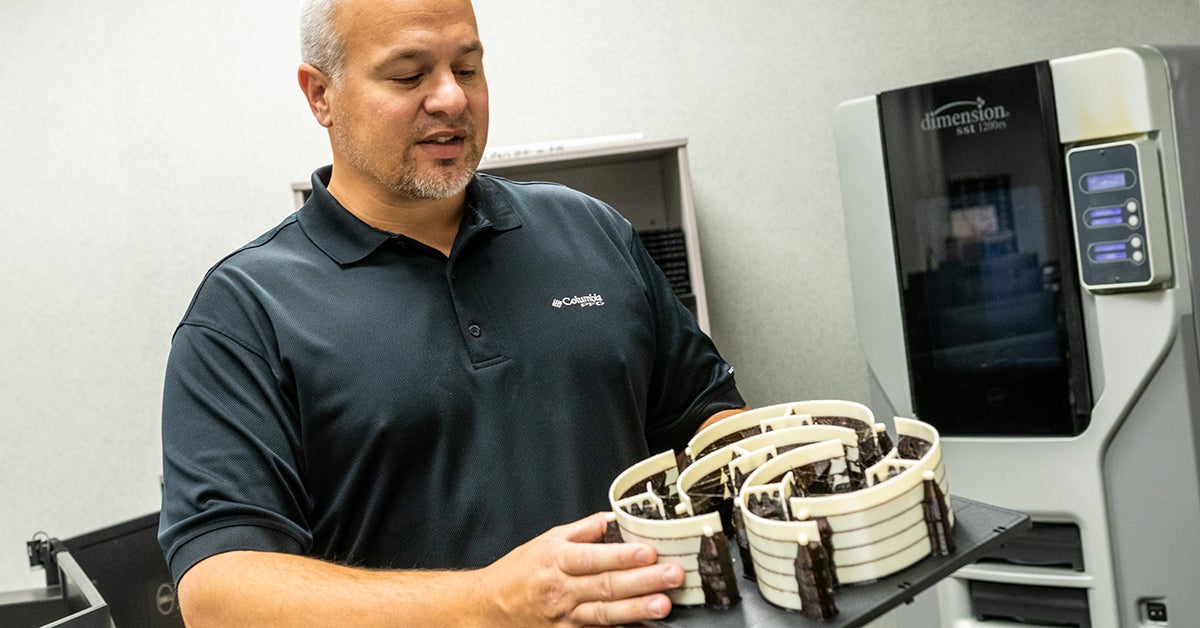Southern Regional instructor joins local effort to 3D print PPE
Published 3:01 pm Friday, April 17, 2020

- SRTC Drafting Instructor Ralph Griffith with a recently printed set of Face Shield components.
|
Getting your Trinity Audio player ready...
|
Southern Regional Technical College (SRTC) Drafting Instructor Ralph Griffith recently joined a combined community effort to produce protective Face Shields for healthcare professionals in South Georgia and beyond using 3D printing technology.
Face shields are personal protective equipment (PPE) devices used by healthcare workers for protection as they work with patients. Face shields are generally used in conjunction with other protective equipment such as disposable masks as an important second layer of protection, especially when treating infectious diseases such as COVID-19.
SRTC is collaborating with other organizations from around South Georgia including Ashley Palmer, Tammy Sharpe, Matt Casper, Will Hanna, Wes Sampson, Michelle Dechman, and Austin Davis of Thomas County Schools, Kristin Blough of Cairo High School, and Robyne Woods of Pelham High School. Several individuals in the Southwest Georgia community are also joining the effort, including Brandon Ray, Ryan Jorge, Dan Bellamy, and Kendra Burrus.
“It’s an honor to join this group of people who are all working selflessly to help protect the health and safety of medical professionals,” said Griffith. “I am proud that together, we can contribute to the war against this virus.”
Utilizing the College’s 3D Printer and the digital design developed by Thomas County Schools’ 3D expert Will Hanna, Griffith can print parts for about 75 shields per week. The process takes about 46 hours per set of 25 parts. Together, the group can produce and distribute about 1000 new face shields to healthcare professionals in need of additional PPE per week. In the past month, the group has provided shields to Archbold Medical Center, doctors’ offices, and the Department of Health in Thomas County as well as facilities in Atlanta, Augusta, and Mississippi.
Thomas County Schools’ Technology Teacher Ashley Palmer says that the project has been a total group effort to serve local people. “When we started this project, we wanted to plug gaps in PPE supply that might exist for our friends and family in the community,” said Palmer.
In an unexpected combination of old and new, some classic school supplies are helping to complete the shields. While the headband portion of the shields is high-tech 3D prints, the transparent plastic portion of the shield is made from the clear sheets used in overhead projectors. Palmer says that the school systems have been generously donating the transparencies required to complete the project.
In the future, Palmer says that the group may use their collective technology to provide other equipment as well. “We’ve discussed pivoting into other 3D prints besides Face Shields. We’ll keep a close watch as to the needs,” he said. “Our type of 3D printing is just a stop-gap and could never serve as a permanent solution. Still, we’re grateful to help.”
Organizations or individuals interested in receiving shields or assisting with the group’s effort may contact Ashley Palmer by emailing apalmer@tcjackets.net. `





